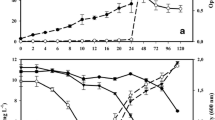Abstract
The capacity of Acidithiobacillus ferrooxidans and Acidithiobacillus thiooxidans to reduce different concentrations of hexavalent chromium in shake flask cultures has been investigated. A. ferrooxidans reduces 100% of chromium (VI) at concentrations of 1, 2.5 and 5 ppm, but in the presence of 10 ppm only 42.9% of chromium (VI) was reduced after 11 days of incubation. A. thiooxidans showed a lower capacity to reduce this ion and total reduction of chromium (VI) was only obtained for concentrations of 1 and 2.5 ppm, whereas 64.7% and 30.5% was reached for 5 and 10 ppm, respectively, after 11 days. A continuous flow mode system was subsequently investigated, in which A. thiooxidans was immobilized on elemental sulphur and the acidic medium obtained was employed to solubilize chromium (III) and to reduce chromium (VI) present in a real electroplating waste [30% of chromium (III) and 0.1% of chromium (VI)]. The system enabled the reduction of 92.7% of hexavalent chromium and represents a promising way to treat this type of waste in the industry.




Similar content being viewed by others
References
Allegretti P, Furlong J, Donati E (2006) The role of higher polythionates in the reduction of chromium (VI) by Acidithiobacillus and Thiobacillus cultures. J Biotechnol 122:55–61
CEC (Council of the European Communities). Council Directive of 12 June 1986 on limit values and quality objectives for discharges of certain dangerous substances (86/280/EEC). Off J Eur Commum L181:16–27
Chang AC, Warneke JW, Page AL, Lund LJ (1984) Accumulation of heavy metals in sewage sludge treated soils. J Environ Qual 13:87–91
Chen S, Lin J (2004) Bioleaching of heavy metals from livestock sludge by indigenous sulphur-oxidizing bacteria: effects of sludge solids concentration. Chemosphere 54:283–289
Chen S, Lin J (2001) Bioleaching of heavy metals from sediment: significance of pH. Chemosphere 44:1093–1102
Clesceri LS, Greenberg AE, Eaton AE (1998) Plasma emission spectroscopy. standard methods for the examination of water and wastewater. APHA, AWWA, WEF, 20th edn. Washington DC
Davis RD (1987) Use of sewage sludge on land in the United Kingdom. Wat Sci Techn 19:1–8
Dowdy RH, Latterel JJ, Hinestly TD, Grossman RB, Sullivan DL (1991) Trace metal movement in an aeric ochraqualf following 14 years of annual sludge application. J Environ Qual 20:119–123
Ebner HG (1978) Metal recovery and environmental protection by bacterial leaching of inorganic waste materials. In: Murr LE, Torma AE, Brierley JA, (eds) Metallurgical applications of bacterial leaching and related microbiological phenomena. Academic Press. pp 195–206
Erdem M (2006) Chromium recovery from chrome shaving generated in a tanning process. J Hazard Mater 129: 143–146
Gadd GM (2000) Bioremedial potential of microbial mechanisms of metal mobilization and immobilization. Current Opinion Biotechnol. 11:271–279
Ganguli A, Tripathi AK (1999) Survival and chromate reducing ability of Pseudomonas aeruginosa in industrial effluents. Lett Appl Microbiol 28:76–80
Guo Z, Zhang G, Fang J, Dou X (2006) Enhanced chromium recovery from tanning wastewaters. J Clean Prod 14:75–79
Jensen AB, Webb C (1995) Ferrous sulphate oxidation using Thiobacillus ferrooxidans: a review. Proc Biochem 30:225–236
Konovalova VV, Dmytrenko GM, Nigmatullin RR, Bryk MT, Gvozdyak PI (2003) Chromium (VI) reduction in a membrane bioreactor with immobilized Pseudomonas cells. Enzyme Microb Technol 33:899–907
Krebs W, Brombacher C, Bosshard PP, Bachofen R, Brandl H (1997) Microbial recovery of metals from solids. FEMS Microbiol Rev 20:605–617
Liu Y, Xu W, Zeng G, Li X, Gao H (2006) Cr (VI) reduction by Bacillus sp. isolated from chromium landfill. Process Biochem 41:1981–1986
Panswad T, Chavalparti O, Chandung C, Anotai J (2001) Economic considerations of chromium recovery from tanning wastewater. Waste Manag Res 19:450–455
Porro S, Donati E, Tedesco P, (1990) Bioleaching of manganese (IV) oxide and application of its recovery from ores. Biotechnol Lett 12:845–850
Rulkens WH, Grotenhuis JTC, Tichy R (1995) Methods of cleaning contaminated soils and sediments. In: Salomons W, Förstner U, Mader P (eds) Heavy Metals, Springer-Verlag, Berlin, pp 151–191
Scheltinga HMJ (1987) Sludge in agriculture: the European approach. Wat Sci Techn 19:9–18
Sisti F, Allegretti P, Donati E (1996) The reduction of dichromate by Thiobacillus ferrooxidans. Biotechnol Lett 18:1477–1480
Sisti F, Allegretti P, Donati E (1998) Bacterial reduction of hexavalent chromium by species of thiobacilli grown on sulphur. Appl Biol Sci 4:47–58
Silverman MP, Lundgren DG (1959) Studies on the chemoautotrophic iron bacterium Ferrobacillus ferrooxidans I. An improved medium and a harvesting procedure for securing high cell yields. J Bacteriol 77:642–647
Solisio C, Lodi A, Veglio F. (2002) Bioleaching of zinc and aluminium from industrial waste sludges by means of Thiobacillus ferrooxidans. Waste Manag 22:667–675
Souza PT, Torres-Mello N, Menezes MM, Montenegro MC, Araujo AN, Barros B, Lins V (2006) Extraction and recovery of chromium from electroplating sludge. J Hazard Mater 128:39–43
Sreekrishan TR, Tyagi RD (1996) A comparative study of the cost of leaching out heavy metals form sewage sludges. Proc Biochem 31:31–41
Tichy R, Rulkens WH, Grotenhuis JTC, Nydl W, Cuypers C, Fajtl J (1998) Bioleaching of metals from soils or sediments. Water Sci Technol 37:119–127
Tuovinen O (1990) Biological fundaments of mineral leaching processes, microbial mineral recovery. McGraw-Hill, New York, pp 55–57
Urone P (1955) Stability of colorimetric reagent for chromium, s- diphenylcarbazide, in various solvents. Anal Chem 27:1354–1355
Veglio F, Beolchini F, Nardini A, Toro L (1999) Bioleaching of a pyrrhotite ore by sulfooxidans strain: kinetic analysis. Chem Eng Sci 55:783–795
Acknowledgements
The authors from University of Cádiz wish to express their sincere gratitude to Dr. Donati from Centro de Investigación y Desarrollo en Fermentaciones Industriales (CINDEFI-CONICET), Universidad Nacional de La Plata, Argentina, where part of this research was carried out. This research was supported by Regional Goberment of Andalusia.
Author information
Authors and Affiliations
Corresponding author
Rights and permissions
About this article
Cite this article
Cabrera, G., Viera, M., Gómez, J.M. et al. Bacterial removal of chromium (VI) and (III) in a continuous system. Biodegradation 18, 505–513 (2007). https://doi.org/10.1007/s10532-006-9083-5
Received:
Accepted:
Published:
Issue Date:
DOI: https://doi.org/10.1007/s10532-006-9083-5




